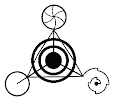Question: Nuwaubian Hotep now that we know that our galaxy the Milky Way has from 200 million to 400 million suns within, how large is our universe which is "all substance matter" (also known to the Kammau/Egyptians as Paut)?
Answer: Very little is known about the size of the universe. It may be trillions of light years across, or even infinite in size. A 2003 paper[20] claims to establish a lower bound of 24 gigaparsecs (78 billion light years) on the size of the universe, but there is no reason to believe that this bound is anywhere near tight. The observable (or visible) universe, consisting of all locations that could have affected us since the Big Bang given the finite speed of light, is certainly finite. The comoving distance to the edge of the visible universe is about 46.5 billion light years in all directions from the earth; thus the visible universe may be thought of as a perfect sphere with the Earth at its center and a diameter of about 93 billion light years Note that many sources have reported a wide variety of incorrect figures for the size of the visible universe, ranging from 13.7 to 180 billion light years. See Observable universe for a list of incorrect figures published in the popular press with explanations ofeach.
Question: How many galaxies such as ours are in our universe (all that there is..)
Answer: There are more than one hundred billion (10 to the 11th power) galaxies in the Universe, each containing hundreds of billions of stars, with each star containing about 1057 atoms of hydrogen.Question: How was the universe created?Answer: The generally accepted scientific theory which describes the origin and evolution of the Universe is Big Bang cosmology, which describes the expansion of space from an extremely hot and dense state of unknown characteristics. The Universe underwent a rapid period of cosmic inflation that flattened out nearly all initial irregularities in the energy density; thereafter the universe expanded and became steadily cooler and less dense. Minor variations in the distribution of mass resulted in hierarchical segregation of the features that are found in the current universe; such as clusters and superclusters of galaxies.
Image of the cosmic microwave background radiation from the Big Bang

According to the Big Bang model, the universe developed from an extremely dense and hot state.
Space itself has been expanding ever since, carrying galaxies (and all other matter) with it.
References:
http://en.wikipedia.org/wiki/Universe
http://en.wikipedia.org/wiki/Big_Bang









No comments:
Post a Comment